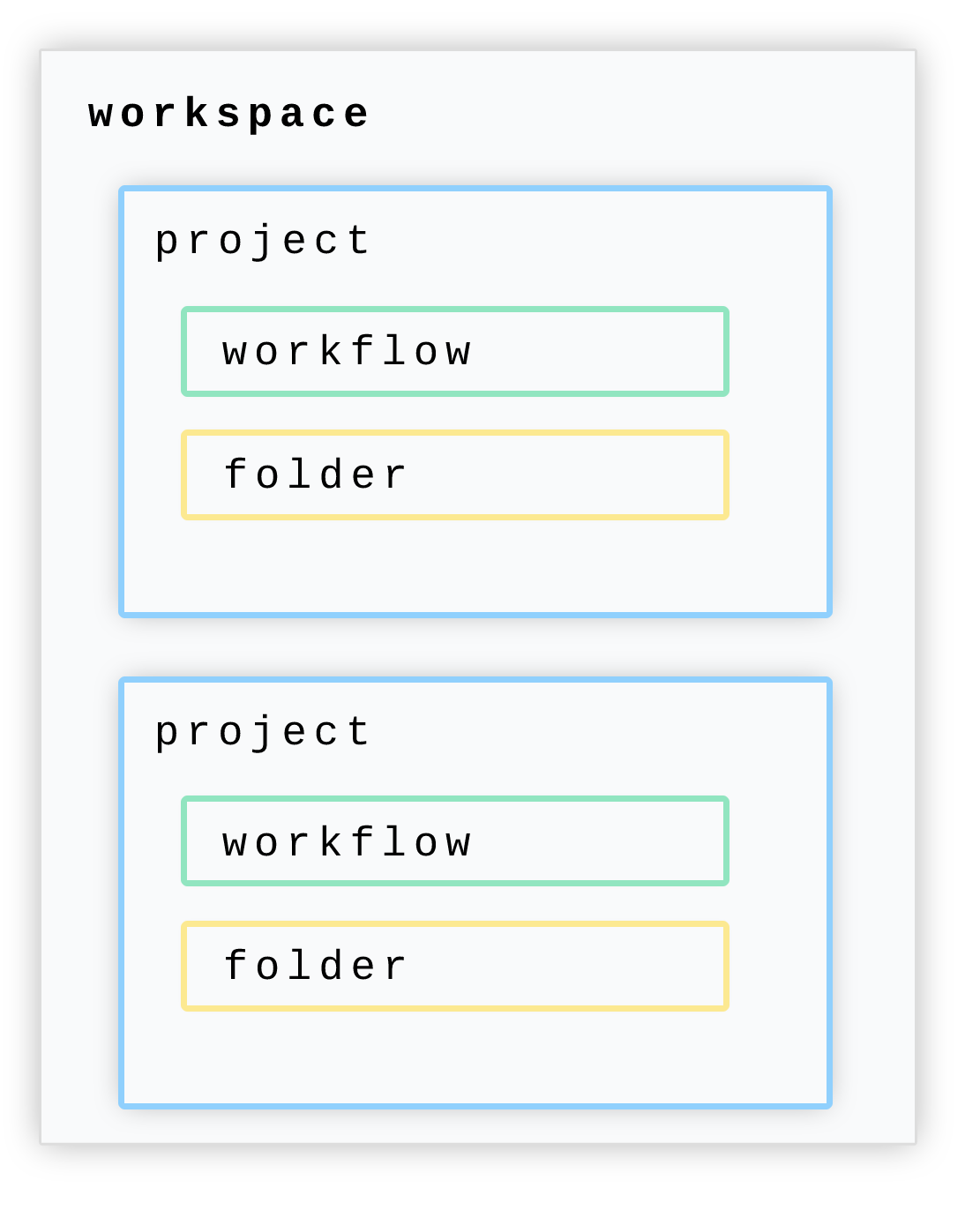Projects
A workspace can contain one or more projects. Projects are a way to organize your workflows into specific groupings or categories.

Getting started with projects
Creating projects
To create a new project, first open the Projects section in the dashboard.
Then click Create project to start a new project.
Enter in your desired name for the project in the prompt, then click Create.
That's it, you now have a dedicated new project created within your workspace. Now you can create workflows within this project, or move workflows into it or create folders for further organization.
Creating folders and workflows in projects
Within a given project, you can create folders for your workflows.
Open your project, and then click the New button for a dropdown to create a workflow in your current project.
Helpful hotkeys to speed up your development
C then Fcreates a new folder.C then Wcreates a new workflow.
Folders can also contain sub-folders, which allows you to create a filing system to organize your workflows.
Moving workflows into folders
To move workflows into folders, simply drag and drop the workflow into the folder.
You can move workflows or folders up a level by dragging and dropping the workflow to the folder icon at the top of the list.
Importing workflows into projects
This only applies to Pipedream accounts that created workflows before the projects feature was released.
To import a workflow from the general Workflows area of your dashboard into a project, first open up the specific project you'd like to import the workflow into.
Then at the top right of the project's page, click the Import button.
You'll be prompted to select a workflow from your Workflows area to import.
Moving workflows between projects
To move a workflow from one project to another project, first check the workflow and then click Move to open a dropdown of projects. Select the project to move this workflow to, and click Move once more to complete the move.

Github Sync limitation
At this time it's not possible to move workflows out of GitHub Synchronized Projects.
Access Controls
The projects list view contains Owner and Access columns.
Owner indicates who within the workspace owns each project. This is typically the person who created the project.

Projects created before February 2024 don't automatically have owners, which has no functional impact.
Access indicates which workspace members have access to each project, and this can be displayed as "me", "Workspace", or "N members".

Permissions
Workspace owners and admins are able to perform all actions in projects, whereas workspace members are restricted from performing certain actions in projects.
| Operation | Project creator | Workspace members |
|---|---|---|
| View in projects listing | ✅ | ✅ |
| View in Event History | ✅ | ✅ |
| View in global search | ✅ | ✅ |
| Manage project workflows | ✅ | ✅ |
| Manage project files | ✅ | ✅ |
| Manage project variables | ✅ | ✅ |
| Manage member access | ✅ | ❌ |
| Manage GitHub Sync settings | ✅ | ❌ |
| Delete project | ✅ | ❌ |
Workspace admins and owners have the same permissions as project creators for all projects in the workspace.
Managing access
By default, all projects are accessible to all workspace members. Workspaces on the Business plan can restrict access for individual projects to specific workspace members.
You can easily modify the access rules for a project directly from the project list view, either by clicking the access badge in the project row (fig 1) or clicking the 3 dots to open the action menu, then selecting Manage Access (fig 2).
Via the access badge (fig 1):

Via the action menu (fig 2):

From here, a slideout drawer reveals the access management configuration:

Toggle the Restrict access to this project switch to manage access:

Select specific members of the workspace to grant access:

You can always see who has access and remove access if necessary:

Project variables and secrets
Environment variables defined at the global workspace level are accessible to all workspace members and workflows within the workspace. To restrict access to sensitive variables or secrets, define them at the project-level and configure access controls for the project.
See here for info on creating, managing, and using environment variables and secrets.
Project variables override workspace variables. When the same variable is
defined at both the workspace and project levels (for example,
process.env.BASE_DOMAIN), the project variable takes precedence.
Frequently Asked Questions
Can sources and connected accounts be organized into projects as well?
At this time no, but that is on our roadmap. Projects will eventually contain all the resources needed for a complete system of workflows to work together.
Can projects be synchronized to a Github repository?
Yes, please read here for more information on the Github synchronization feature for projects.
Can I configure which members in my workspace have access to individual projects?
Yes! Learn about managing access here.